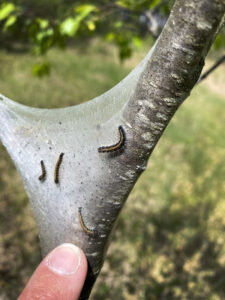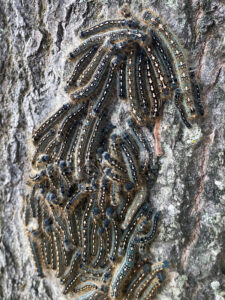Linda Williams, DNR Forest Health Specialist, Woodruff
Linda.Williams@wisconsin.gov or 920-360-0665

Eastern tent caterpillars and their webs start out small but grow quickly. Photo: Linda Williams, Wisconsin DNR.
Have you seen trees along roadsides with white webs in them? Eastern tent caterpillars (ETC) are hatching and beginning to feed on host trees, including cherry, apple and crabapple.
Landowners and homeowners may notice the white silken tents forming in branch forks. Although they form unsightly nests, ETC is a native insect, so management is not typically necessary. Even completely defoliated trees will produce new leaves within a few weeks.

A group of forest tent caterpillars rests on the bark of a tree. Photo: Linda Williams, Wisconsin DNR.
Although landowners may want to “burn them out,” it is not recommended to burn the nests in the trees. This can damage the tree more than the defoliation from the caterpillars would. You could even start a wildfire. Instead, landowners can pull the webs out of the trees with a rake or with their hands and soak it in a bucket of soapy water to kill the caterpillars. The best time to remove nests is early morning or evening, when the caterpillars are inside.
Insecticides are rarely necessary, but if used they should penetrate inside the tent and should be labeled for use on trees. It is not recommended to prune branches or soak the tents with WD-40 as these methods are more harmful to the tree than ETC defoliation and are not necessary.
Another native caterpillar showing up in localized areas and causing defoliation is the Forest Tent Caterpillar. Unlike Eastern Tent Caterpillar, Forest Tent Caterpillar does not create webs in trees. Forest tent caterpillar prefers to feed on aspen, oak and ash. Small, localized areas of defoliation have already been reported in areas of Taylor and Oneida Counties.
For more information on eastern tent caterpillar, check out this fact sheet from the University of Wisconsin-Madison Division of Extension. Compare it to forest tent caterpillar information.
